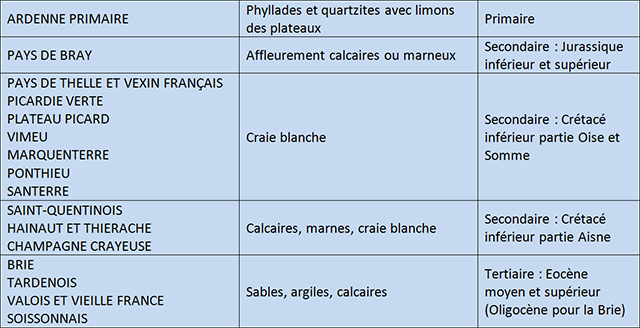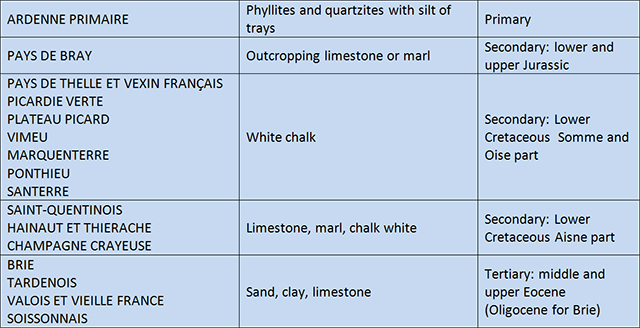
Picardie : géologie et forêts
La Picardie repose sur la partie Nord du Bassin sédimentaire de Paris et comprend deux complexes géologiques majeurs :
- L'affleurement de l'auréole de Crétacé supérieur datant du Secondaire, sous un faciès de craie largement développé sur les territoires de la Somme, du Nord de l'Aisne et de l'Ouest de l'Oise.
- L'affleurement des sédiments datant du Tertiaire (sables et argiles de l'Eocène principalement et sables de Fontainebleau de l'Oligocène) déposés sur le substrat crayeux au Sud de l'Aisne et à l'Est de l'Oise.
Plus localement, des terrains plus anciens d'âge Jurassique affleurent en limite de la Thiérache en marge des massifs primaires des Ardennes et dans le Beauvaisis à la Boutonnière du Pays de Bray. Ces terrains sont formés par des argiles ou des calcaires relativement imperméables.
Types de formations géologiques par région forestière

Le Quaternaire joue un rôle important en ayant apporté les alluvions et les limons de plateaux. Les alluvions anciennes se retrouvent dans les vallées et les alluvions modernes, argilo-sableuses ou tourbeuses, forment le lit des rivières et des rus principaux. Le limon des plateaux recouvre en grande partie les formations plus anciennes sur des épaisseurs variables pouvant aller jusque 10m (Valois, Soissonnais, Tardenois).
On trouve aussi de l'argile à silex provenant de la décalcification de la craie.

Bois Magneux - Fau Timon
Situé à 10km au sud-est d'Amiens, les bois de Bois Magneux, d'une superficie de 33ha sur le territoire de la commune de Cottenchy, et de Fau Timon, 28ha sur le territoire de la commune de Boves, constituent une partie de la forêt de la ville d'Amiens.
En rebord du plateau sud amiénois, ils sont séparés de 500m environ par une vallée sèche ("le Vallon") cultivé par le lycée agricole du Paraclet.
Histoire
Ces bois appartiennent à la ville d'Amiens depuis 1971. Ils proviennent de la vente par les hospices d'Amiens de leur domaine boisé qui comprenait notamment, outre Bois Magneux et Fau Timon, les bois de Creuse, Bacouel, Malplatel constituant actuellement la forêt domaniale de Creuse (290ha) et le bois des Dames (45ha).
Très anciennement les bois de Fau Timon, des Dames, Bucaille et Magneux appartenaient à l'Abbaye du Paraclet. Ils avaient été concédés à l'hôtel Dieu d'Amiens pour le bois "des faux Timons", à l'hospice Saint-Charles pour Bois Magneux en remplacement de leurs biens aliénés par un décret de l'an XIII et la loi du 7 septembre 1807.
Géologie
Le sous-sol est constitué par le socle crayeux du Plateau Picard (Crétacé supérieur). La craie apparaît sur les pentes raides des bois Magneux et de Fau Timon.
Des formations quaternaires sont venues se superposer sur les parties en plateau :
- Fau Timon : cailloutis de silex ;
- Bois Magneux : colluvions de versants.
La earthcache

Pour pouvoir valider cette earthcache, vous devrez répondre aux questions suivantes, dont les réponses se trouvent sur le panneau d'information situé aux coordonnées indiquées.
Merci d’envoyer vos réponses via mon profil ou via la messagerie geocaching.com, ne les donnez pas dans votre log.
Vous pouvez ensuite loguer la cache "found it", je vous contacterai en cas de problème.
1) Dans quelle région forestière (voir tableau bleu du descriptif) se situent les bois Magneux et de Fau Timon ?
2) Sur quels versant des bois Magneux et de Fau Timon la craie affleure-t-elle ?
3) A quoi correspondent les cailloutis de silex de Fau Timon ?
4) De quoi sont constitués les colluvions de Bois Magneux ?
5) Vous pouvez également ajouter à votre log une photo de vous ou de votre gps devant le panneau parlant des crapauducs (facultatif mais grandement apprécié).

Picardie : geology and forests
Picardy is based on the northern part of the Sedimentary Basin of Paris and has two major geological complex:
- The outcrop of the halo of Cretaceous dating from the Secondary, as a chalk facies widely developed in the territories of the Somme, Northern Aisne and Western Oise.
- The outcrop of Tertiary sediments (sand and clay from the Eocene and mainly Fontainebleau sands of Oligocène) deposited on the chalky substrate at south of the Aisne and east of the Oise.
More locally, the oldest land of Jurassic outcrops on the edge of the Thiérache sidelines primary mass of the Ardennes and in the Beauvaisis in the buttonhole of the Pays de Bray. These lands are formed by clays or relatively impermeable limestone.
Types of geological formations by forest region

Quaternary plays an important role in having brought the alluvial silt and trays. The old alluvium are found in the valleys and modern alluvial, sandy-clay or peat, form the beds of rivers and major rus. Silt trays covers much of the oldest formations of variable thicknesses ranging up to 10m (Valois, Soissons, Tardenois).
There are also clay with flints from decalcification of chalk.

Bois Magneux - Fau Timon
Located 10 km south-east of Amiens, the woods of Bois Magneux, a 33ha area in the territory of the town of Cottenchy, and Fau Timon, 28ha on the territory of the municipality of Boves, are part of the forest of the city of Amiens.
In southern edge of plateau of Amiens, they are separated by about 500m of a dry valley ("the Valley") cultivated by the agricultural college of the Paraclet.
History
These woods belong to the city of Amiens in 1971. They come from the sale by hospices of Amiens of their forested area which included in particular, besides Bois Magneux and Fau Timon, forests of Creuse, Bacouel, Malplatel currently constituting the forest domaniale Creuse (290 ha) and wood "des Dames" (45 ha).
Very formerly the wood Fau Timon, "des Dames", Bucaille and Magneux belonged to the Abbey of the Paraclet. They had been granted to the "hôtel Dieu" of Amiens for wood "des faux Timons" at St. Charles Hospice Bois Magneux replacing their property alienated by a decree of the year XIII and the Law of 7 September 1807.
Geology
The basement consists of the chalky base of Plateau Picard (upper Cretaceous). Chalk appears on the steep slopes of wood Magneux and Fau Timon.
Quaternary formations were superimposed on top parts:
- Fau Timon: flint pebbles;
- Bois Magneux : colluvium of side.
The earthcache

To be able to validate this earthcache, you will have to answer the following questions, which answers are on the information board at coordinates (only in French).
Thank you for sending your answers via my profile or the geocaching.com messaging, don't take it in your log.
You can then post your log "found it", I shall contact you in case of problem.
1) In which forest region (see blue table of the listing) are woods Magneux and Fau Timon?
2) On which side of the wood Magneux and Fau Timon chalk does outcrop?
3) What are the flint pebbles at Fau Timon ?
4) What are the colluvium of Bois Magneux composed of?
5) You can also add to your log a photo of you or you GPS in front of the board talking about crapauducs (optionnal but greatly appreciated).